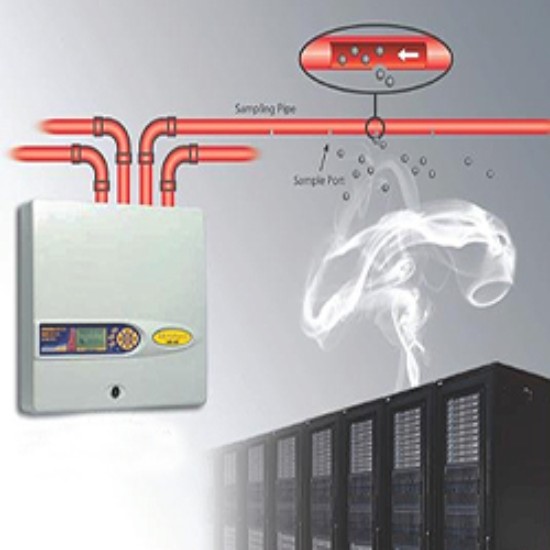
Active vs Passive Smoke Detection
Air sampling smoke detectors are “active” systems which constantly sample the air from multiple points throughout the environment. Other smoke detection devices are “passive” systems. They rely on the heat of the smoke and the airflow of the room, for the smoke or heat to reach the detector. This can be a problem in rooms with constant air flows like server rooms, with smoldering fires which generate relatively little smoke, and with incipient stage fires where the smoke is not hot and therefore has very little thermal lift. Since these environmental conditions are particularly prevalent in server rooms, this is one space where air sampling smoke detectors are best used.
Server Room Fire Prevention with Air Sampling Smoke Detectors
Air sampling smoke detectors are classified as Very Early Warning Smoke Detectors (VEWSD). This is especially important in server rooms where the incipient stage of an electrical fire may not be detected by EWSD (Early Warning Smoke Detectors). This stage, which can last for hours or even days, is not a visible fire but the human nose may smell the fumes.
Smoke from a server room fire is harmful to other electrical equipment in the space. The by-products of smoke from PVC and digital circuit boards are gases such as HCL, and these gases will cause corrosion of IT equipment. Even at very low levels, the gas can cause moderate corrosion with long-term effects on electronics.
Air sampling smoke detectors can detect smoke at this incipient stage to activate alarms so that a response can be taken (whether through a fire suppression system or by an individual trained to respond) to put out and address the cause of the fire. Because the system monitors the space for overheating materials, and can detect this even before an actual fire develops, air sampling detectors act as a fire prevention tool.
How Air Sampling Smoke Detection Works
Air sampling smoke detectors are quite different from conventional spot type smoke detectors. Aspirating systems are typically made up of a number of small-bore pipes laid out above or below a ceiling in parallel runs, some feet apart. Small holes, also some meters apart, are drilled into each pipe to form a matrix of holes which are the sampling points, providing an even distribution across the ceiling. Air or smoke is drawn into the pipework through the holes and onward to a very sensitive smoke detector mounted nearby, using the negative pressure of an aspirator (air pump).
While air sampling smoke detectors are more sensitive to detecting smoke, they are less susceptible to the major sources of false alarms – dust, draughts and electrical interference. False alarms are a definite annoyance to building owners, managers and tenants. They also have a higher cost for our fire service providers, click here to read about the true cost of false alarms.
Sensitivity Settings of Air Sampling Smoke Detection Systems
Aspirating Smoke Detectors can have the sensitivity settings for alarm levels adjusted. The levels are typically set for an Alert, Action, and Fire 1. An Alert sends notice to local staff so they can investigate the threat of fire that has been detected. The Action level is generally used to initiate smoke control, begin a warning sequence via the evacuation system, and alert further staff members to the situation. The Fire 1 alarm indicates a fire condition is very close or has started. This alarm would activate evacuation procedures for the building, the fire alarm panel for the affected zone is activated, notifying the monitoring company and fire services. An additional Fire 2 threshold can be set; this level would act as confirmation of a serious fire event with the option to activate a suppression system. This should be a safety net setting, as the building’s fire systems and procedures should have operated properly before this point to prevent the fire.
For more in-depth information about the advantages of 725 psi clean agent systems, check out A1’s Lunch & Learns for architects and engineers.
A1 is a leading expert on the latest technology in life safety. To find out more information or to ask a question, click here or call us at 1-800-859-6198.
